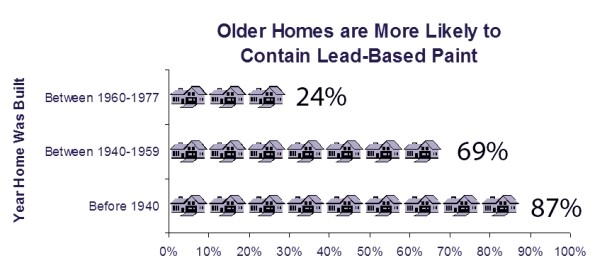
Message from Code Enforcement: Why Flaking & Peeling Paint on Your Home Could be a Problem
I recently received a Courtesy Notice from Code Enforcement alerting me to flaking and peeling paint on my house. Why is this a problem?
This information from the Environmental Protection Agency might be helpful:
Older Homes and Buildings
If your home was built before 1978, it is more likely to have lead-based paint. In 1978, the federal government banned consumer use of lead-based paint, but some states banned it even earlier.
Lead-based paint is still present in millions of homes, normally under layers of newer paint. If the paint is in good shape, the lead-based paint is usually not a problem. Deteriorating lead-based paint (peeling, chipping, chalking, cracking, damaged, or damp) is a hazard and needs immediate attention.
Lead-based paint may also be a hazard when found on surfaces that children can chew or that get a lot of wear-and-tear, such as:
- Windows and window sills;
- Doors and door frames; and
- Stairs, railings, banisters, and porches.
A few tips to reduce sources of lead exposure in older homes and buildings:
- Inspect and keep all painted surfaces in excellent shape and clean up dust frequently with a wet cloth or paper towel.
- Consult a certified lead professional before beginning renovation, repair or painting projects. Renovation, repair or painting activities can create toxic lead dust when painted surfaces are disturbed or demolished.
- Avoid tracking lead dust into the home by wiping and removing shoes before entering the home and placing dust mats both inside and outside of entryways.
- Learn if you have a lead service line. Contact your water utility or a licensed plumber to determine if the pipe that connects your home to the water main (called a service line) is made from lead.
Soil, Yards and Playgrounds
Soil, yards and playgrounds can become contaminated when exterior lead-based paint from houses or buildings flakes or peels and gets into the soil. Soil may also be contaminated from past use of leaded gasoline in cars, from industrial sources, or even from contaminated sites, including former lead smelters. Lead is also naturally occurring and it can be found in high concentrations in some areas.
Lead in soil can be ingested as a result of hand-to-mouth activity that is common for young children and from eating vegetables that may have taken up lead from soil in the garden. Lead in soil may also be inhaled if resuspended in the air or tracked into your house thereby spreading the contamination.
Older playground equipment can still contain old lead-based paint, and artificial turf and playground surfaces made from shredded rubber can contain lead. Take precautions to ensure young children do not eat shredded rubber or put their hands in their mouth before washing them.
To reduce exposures to lead from soils, yards and playgrounds:
- Check the exterior of your home, including porches and fences, for flaking or deteriorating lead-based paint that may contaminate soil in your yard or be tracked into your house.
- Put doormats outside and inside all entryways and remove your shoes before entering to avoid tracking contaminated soil into your house.
- Wash hands several times a day using soap and water, especially after playing or working outside.
- Plant bushes close to the house to keep children from playing in soil near your home.
In addition to the lead-based paint concerns, please remember that paint is a protective coating. Without it, wood can rot and metal can rust. Rotted wood and rusted metal can cause structural safety issues.
Learn more about Code Enforcement Initiatives on the City webpage.

